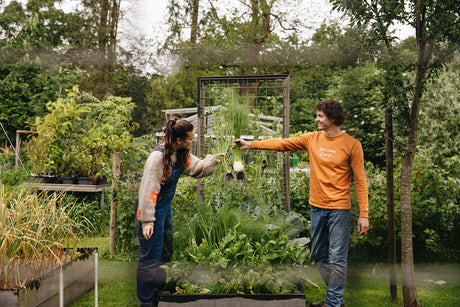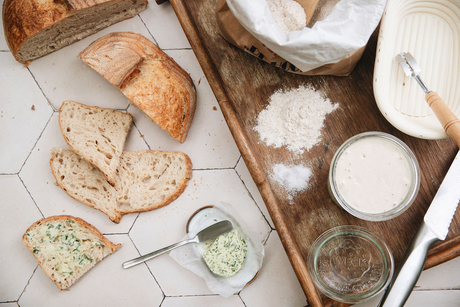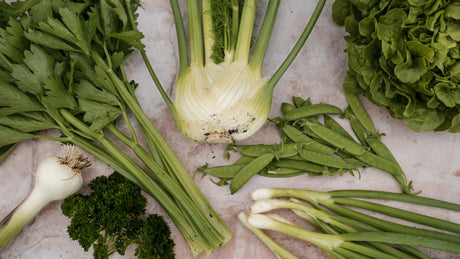pH acidity in the vegetable garden soil
Everyone knows the phenomenon. We have a piece of vegetable garden that we have worked perfectly. The soil has been loosened with a
spading fork . The soil is well fertilized, weed-free and we are ready to grow vegetables or fruit. We are super enthusiastic to follow the cultivation and yet it goes wrong.

Blossom end rot due to calcium deficiency
Our
cauliflowers are just like tangerines and immediately shoot into bloom. Or our
tomatoes are small and gradually get a brown nose (nose rot). And yet we have
used special fertilizers , the soil is nice and crumbly and we keep everything weed-free. What could possibly be the problem here?

The answer to many vegetable garden problems does not lie in sufficient nutrition or good soil structure. The key to many vegetable garden problems often lies in the acidity of your soil. Compare it to the morning after a night out with friends and too much wine or beer. The table may be set with delicious breakfast pastries and steaming coffee. Yet it may be that you cannot get a bite or sip down. There is little you can do about a hangover, but fortunately you can do something about the acidity of your vegetable garden soil.
pH in the vegetable garden soil

Ph Acidity in the vegetable garden
An incorrect acidity for a certain crop, ensures that the crop does not get a bite. The nutrients may be present in abundance in the soil, if the acidity is not right, your plants may not absorb enough. An example: The acidity in my vegetable garden is 7.2 (average measured at 6 locations in my garden). In my vegetable garden it is very difficult to grow
celery because celery grows ideally between pH 5.9 and 6.9. The plant remains small and does not stand upright. Why is that?
The acidity in your vegetable garden is determined by the amount of alkaline in your soil. The more alkaline in your soil, the more
basic your soil is, the less alkaline in the soil, the more
acidic your soil. In the article
The soil: The ABC of the vegetable garden soil you could read that the roots of our plants have small mouths that can absorb minerals and nutrients. Roots of plants absorb the nutrient molecules such as
nitrogen ,
potassium ,
phosphorus ,
magnesium , calcium, boron, ...
The pH scale for acidity ranges from 0 to 14. The lowest values indicate acid, the highest values indicate basic soil with a lot of alkaline. The higher the Ph, the less acidic your soil (think the other way around). Food shortages in plants occur when the soil is too acidic or too basic. Vegetable garden nutrients are on average most easily absorbed at a neutral pH of 6.8. The value of your vegetable garden soil will fluctuate between values 4 (very high acidity) and 8 (very basic). Most plants feel great in a vegetable garden soil with a pH between 6.0 and 7.5.
You can purchase
your own pH meter on this site. This will help you to tell you what the acidity of your vegetable garden soil is. You can also send a soil sample to a
recognized center for soil research . There they will analyze your soil not only for acidity but also for the most important nutrients, the amount of organic material, possibly harmful metals, ... etc.
IMPORTANT :
Too low a pH (acidic soil) prevents plants from absorbing
phosphorus , calcium, potassium and
magnesium
Too high a pH (basic soil) prevents plants from absorbing boron, copper, zinc, manganese and iron.
The pH values for vegetables and herbs

Delicious vegetables from the vegetable garden
Below is a list of vegetables and herbs and their preferred pH values. This way you can see for yourself how to prepare your different beds. Also read in the article Crop rotation in the vegetable garden which vegetables you best plant together with crop rotation. It can be easy to prepare your beds in function of your crop rotation. For example, in your
potato bed you can process a lot of
compost because
potatoes love acidic soil.
potatoes : 4.5 - 6.0
Strawberries: 6.0 - 6.8
Endive: 5.0 - 6.8
Artichokes: 6.5 - 7.5
Asparagus: 6.0 - 6.5
eggplant : 5.5 - 7.0
Pickle: 5.5 - 6.8
basil : 5.1 - 8.5
Chives: 6.0 - 7.0
cauliflower : 6.5 - 7.0
kale : 6.0 - 7.5
beans (bush): 6.0 - 7.5
beans (cut): 6.0 - 7.5
beans (stalk): 6.0 - 6.8
broccoli : 6.0 - 7.5
Zucchini: 6.0 - 7.5
dill : 6.0 - 7.5
dragon : 6.0 - 7.5
peas : 6.0 -7.5
Chervil: 5.0 - 8.2
celeriac : 6.0 - 7.0
fennel bulb : 6.1 - 7.8
Garlic : 5.5 - 7.5
Kohlrabi: 6.5 - 7.0
Kohlrabi: 6.0 - 6.8
cucumber : 5.5 - 7.5
Coriander: 4.9 - 8.2
corn : 5.5 - 7.0
Coin: 6.0 - 7.5
paprika : 5.5 - 7.0
parsnip : 6.0 - 6.5
pepper : 5.5 - 7.0
Parsley: 5.6 - 6.0
pumpkin : 5.5 -7.5
leek : 6.5 - 7.0
Rhubarb: 5.5 - 6.8
Radish: 6.0 - 7.0
Beetroot : 6.0 - 7.5
red cabbage : 6.0 - 7.5
Rosemary: 5.5 - 7.0
Arugula: 6.0 - 6.8
Sage: 4.9 - 8.2
Savoy cabbage: 6.0 - 7.5
Celery: 5.9 -6.9
Shallot : 6.0 - 7.0
Lettuce: 6.0 - 7.0
Sleeping peas : 6.0 - 7.5
spinach : 6.0 - 7.0
Brussels sprouts: 6.0 - 6.8
Swiss Chard: 6.0 - 7.5
Stem onion : 6.0 - 7.0
Thyme: 6.0 - 7.0
Tomatoes: 5.5 - 7.5
broad beans : 6.5 - 7.5
Onion: 6.0 - 7.0
lamb's lettuce : 5.6 - 7.5
Watermelon: 5.5 - 7.0
White cabbage: 6.0 - 7.5
carrots : 5.5 - 7.0
Sweet potato: 5.6 - 6.5
How do I adapt to the acidity in my vegetable garden?
You can adjust the pH in your vegetable garden soil to the needs of your plants. But you can also grow only the vegetables that feel good at the pH value of your garden.
You can make acidic soil more basic (thus raising the pH) by adding
lime to your vegetable garden.
Lime contains calcium and
magnesium . So you can make the soil less acidic and feed it at the same time.

Vegetable garden facts pH meter
You can make basic soil more acidic by adding organic matter to your garden such as
compost , tarred manure, peat, or a combination of these.
Note that it is more difficult to make a basic soil acidic than an acidic soil more basic. Also know that the soil that goes through an earthworm comes out more and more neutral. Let me explain myself. If your soil is too basic, the worm droppings are more acidic than your soil. If your soil is too acidic, the worm droppings are more basic. A healthy soil life is therefore very good for the acidity. Mulching (covering your soil with organic material) can help with this.
Changing the pH value in your vegetable garden is not an exact science and takes time. There are no miracle cures and you cannot expect immediate results. After adding
lime (for too acidic soil) or organic material (for too basic soil) it is best to wait 40 to 60 days before getting your
pH meter out again. Do not expect more than 0.5 to 1 pH value difference. Work gradually to achieve the pH that suits the plants you want to grow. A good time to do your first pH measurement is in the fall. In the spring of the following year you should already see whether your efforts have been rewarded. It is best to check your pH values twice a year.
Good luck, Tom
 Blossom end rot due to calcium deficiency
Blossom end rot due to calcium deficiency The answer to many vegetable garden problems does not lie in sufficient nutrition or good soil structure. The key to many vegetable garden problems often lies in the acidity of your soil. Compare it to the morning after a night out with friends and too much wine or beer. The table may be set with delicious breakfast pastries and steaming coffee. Yet it may be that you cannot get a bite or sip down. There is little you can do about a hangover, but fortunately you can do something about the acidity of your vegetable garden soil.
The answer to many vegetable garden problems does not lie in sufficient nutrition or good soil structure. The key to many vegetable garden problems often lies in the acidity of your soil. Compare it to the morning after a night out with friends and too much wine or beer. The table may be set with delicious breakfast pastries and steaming coffee. Yet it may be that you cannot get a bite or sip down. There is little you can do about a hangover, but fortunately you can do something about the acidity of your vegetable garden soil.
 Ph Acidity in the vegetable garden
Ph Acidity in the vegetable garden Your own pH and humidity meter
Your own pH and humidity meter
 Delicious vegetables from the vegetable garden
Delicious vegetables from the vegetable garden Vegetable garden facts pH meter
Vegetable garden facts pH meter






